60 years of Doctor Who: A look back at the sci-fi show’s most iconic moments
Happy 60th, Doctor Who! Here's our round-up of the show's most iconic moments.
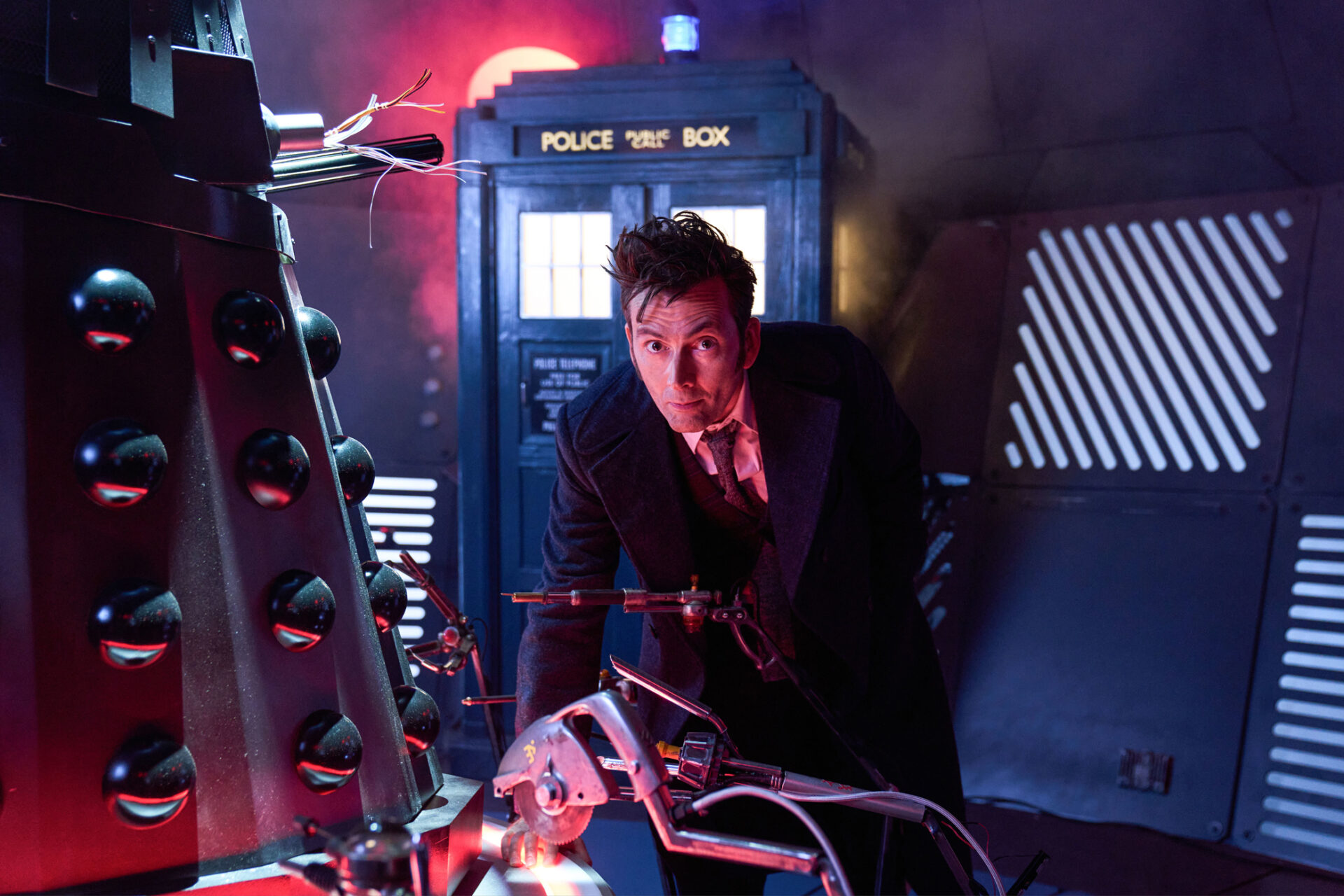
From the Tardis to the arrival of the Cybermen, via the multiple incarnations of its Doctor – including its first female and first Black and queer person – Doctor Who has been as intrinsic to British identity as tea and biscuits and Paddington Bear. As the BBC prepares to celebrate Doctor Who‘s diamond jubilee, we mark six decades of time travel by selecting some standout episodes from the legendary series.
An Unearthly Child’, 1963
In the very first episode, broadcast the day after the assassination of JFK, viewers see two concerned London schoolteachers follow a mysterious pupil to her home — which turns out to be an old police box standing in a junkyard. When they push past the girl’s unhelpful, cantankerous grandfather and into the box, they find themselves in a strange gleaming control room that is somehow bigger on the inside!
‘The Dalek Invasion of Earth’, 1964
The Daleks had proved an instant hit when they first appeared in only the second Doctor Who serial and were quickly booked for a return appearance. Only this time they were terrorising our own planet with a full-scale invasion. Location footage in the second episode of this story shows the metal monsters gliding around Trafalgar Square and over Westminster Bridge, having truly become the masters of Earth.
‘The Time Meddler’, 1965
An adventure in Northumbria in 1066 takes an unexpected turn when the Doctor’s companions, Steven and Vicki (Peter Purves and Maureen O’Brien), climb through a door in a medieval altar belonging to a mysterious monk – only to find themselves in a TARDIS control room identical to the one that they travel in. This is the first time that we ever encounter another member of the Doctor’s as-yet-unnamed race.
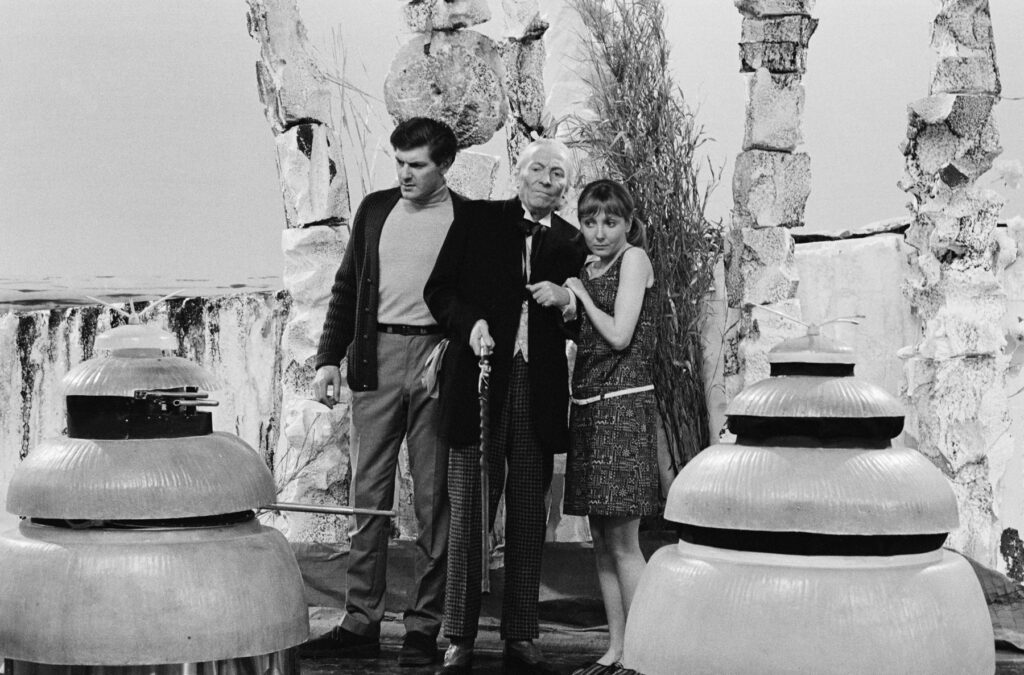
‘The Tenth Planet’, 1966
Not only did this story feature the first appearance of iconic villains the Cybermen, but it also found a very novel way to deal with the fact that the lead actor (William Hartnell) was unable to continue in the role of the Doctor, due to ill health. At the end of the adventure, the character collapses onto the floor of the TARDIS and, before our very eyes, his features morph into those of character actor Patrick Troughton. The first ever ‘regeneration’ had taken place. (But was yet to be referred to as such.)
‘The Highlanders’, 1967
The final scene of this Highland fling originally sees the TARDIS crew bidding a fond farewell to Scottish guest character Jamie McCrimmon, played by Frazer Hines. However, the young actor’s performance so impressed the producers that the scene was specially re-shot to show McCrimmon joining the TARDIS travellers on board the time-ship, where he would go on to become the longest-running Doctor Who companion of all time.
‘The Web of Fear’, 1968
This story was the prime reason that many children steadfastly refused to travel on the Tube in the late 1960s, featuring as it does one of the most memorable sequences of the Patrick Troughton era. Great hairy robotic Yeti — controlled by the Great Intelligence — swarm through the tunnels of the London Underground, spraying deadly web guns and massacring the soldiers of the newly formed United Nations Intelligence Task Force. Apparently, the Tube station sets were so convincing that London Transport made a complaint about unlicensed filming on their premises.
‘The War Games’, 1969
After an epic 10-part adventure, the Doctor’s own people catch up with him. The Time Lords put their errant son on trial and declare him guilty of meddling in the affairs of other races. The punishment is to be a forced regeneration and exile to Earth. The last we see of the Second Doctor is a faceless figure spinning off into a black void…
‘Spearhead from Space’, 1970
A new decade and a new format. Now in colour, the show sees the Third Doctor — played by comic actor Jon Pertwee — permanently based on Earth and attached to paramilitary group UNIT as their scientific advisor, serving under Brigadier Lethbridge-Stewart (Nicholas Courtney). The climax of this first adventure of the new era features shop-window dummies coming to life and shooting down the innocent pedestrians of Ealing Broadway.
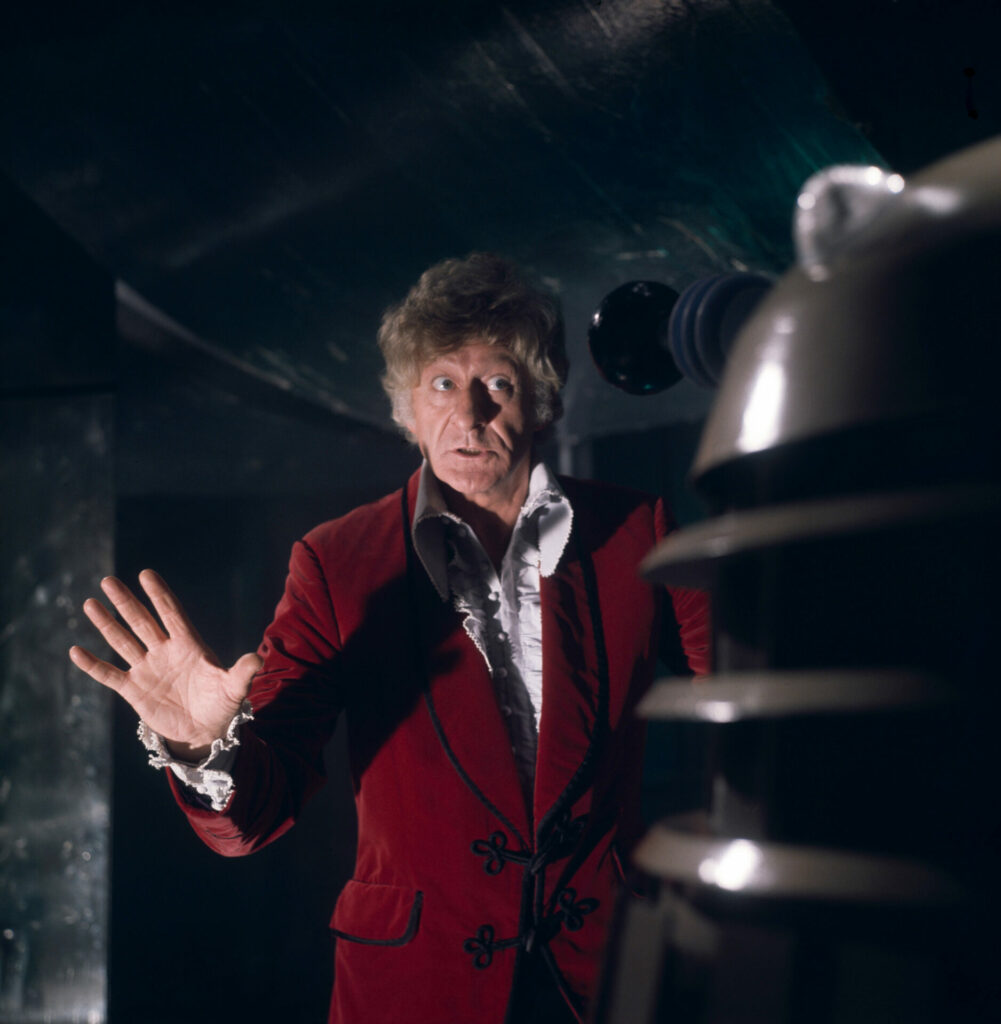
‘Terror of the Autons’, 1971
The debut serial of the 1971 season sees the introduction of a new character created by producer Barry Letts and script editor Terrance Dicks — an evil Time Lord designed to be something of a ‘Moriarty’ figure for the Doctor. ‘The Master’ (Roger Delgado), as this meddling jackanapes introduces himself, would go on to be revealed as the ‘surprise’ villain in every single story of that year.
‘The Curse of Peladon’, 1972
On a mission for the Time Lords, the Doctor and his assistant Jo Grant (Katy Manning) visit the alien world of Peladon, which is being considered for membership to the Galactic Federation. Debate over whether to join or not rages among the locals and attempts to derail the application by superstitious extremists are defeated by the Doctor. Later that year – in the real world – the UK would formally join the European Union.
‘The Three Doctors’, 1973
The tenth anniversary celebrations kicked off a little early with this celebratory story actually beginning transmission at the end of December ’72. The first three Doctors join forces to defeat Omega, an ancient villain trapped within a black hole. Sadly, William Hartnell was prevented by his deteriorating health from participating fully but does appear on a monitor screen opposite his successors Troughton and Pertwee. The Time Lords reward the Doctor by ending his exile and restoring his control of the TARDIS.
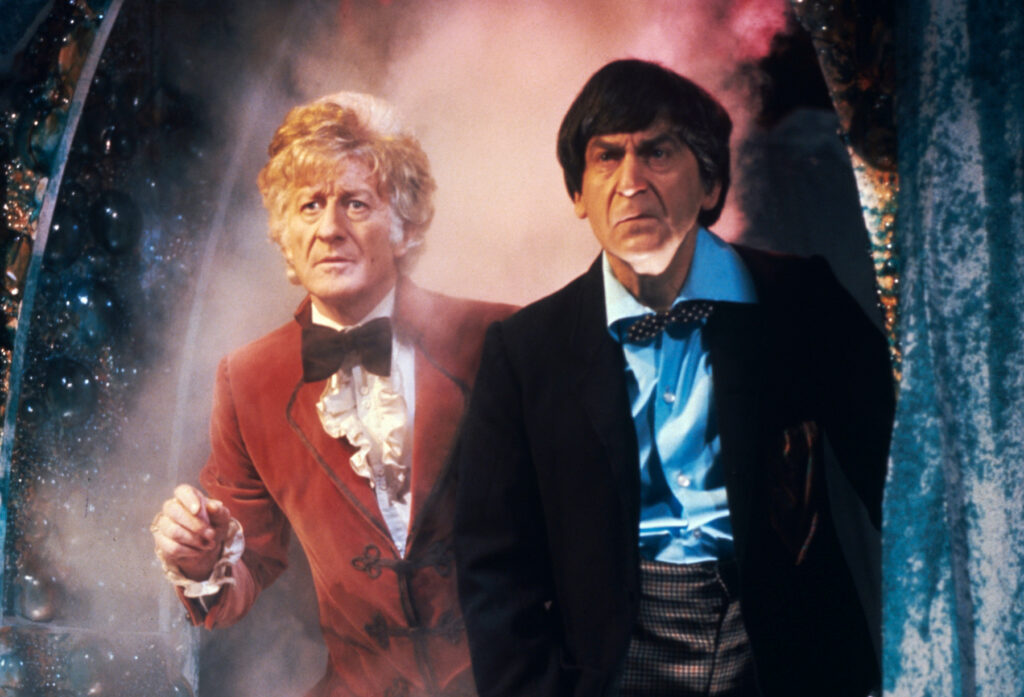
‘Planet of the Spiders’, 1974
Now travelling with journalist Sarah Jane Smith (Elizabeth Sladen), the Third Doctor visits the famous blue planet Metebelis Three, where he is forced to face his fears. This Buddhist-inspired tale ends with Jon Pertwee falling out of the TARDIS and regenerating into Tom Baker’s Fourth Doctor. “Well,” says the Brigadier, “here we go again…”
‘Genesis of the Daleks’, 1975
Tom Baker’s gripping first series as the Doctor includes an assignment from the Time Lords to journey back to the origins of the Daleks on their home planet of Skaro and attempt to either avert or hinder their creation. As well as meeting Davros, the evil genius who created the diabolical dustbins, the Doctor also wrestles with a moral dilemma as he hesitates from allowing two wires to touch – an act that could wipe the Daleks from ever existing. Does he have the right…?
Pyramids of Mars’, 1976
Often hailed by fans as one of the greatest adventures of all time, this heady fusion of Egyptology and outer-space shenanigans is full of unsettling imagery, including robot mummies and jackal-headed gods. The story is set in 1911, and Sarah Jane points out that they know that the world doesn’t end then – as she’s from 1980. The Doctor then takes her to the devastated Earth of an alternate 1980, illustrating that time is always in flux.
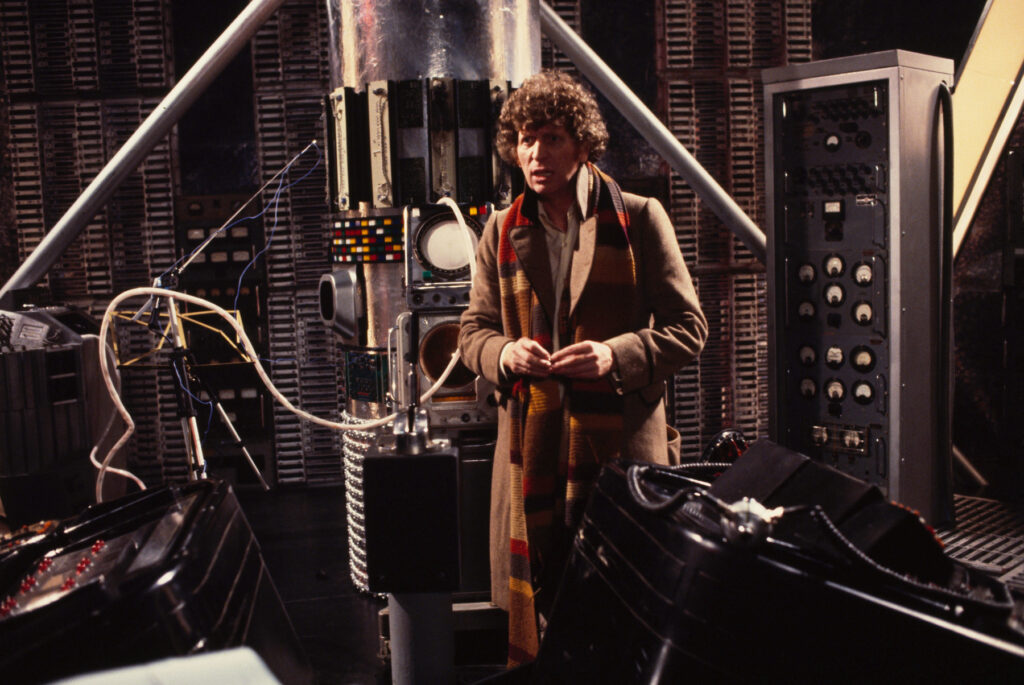
‘The Talons of Weng-Chiang, 1977
Once considered a pinnacle of Doctor Who, this serial now has a more troubled reputation due to the way it handles race. Many of the Chinese supporting roles are reduced to offensive stereotypes, and the lead Asian villain is played by a white actor in ‘yellow-face’. It still stands up as an atmospheric piece of drama, but it’s important to be aware of and discuss such problematic elements. Mr Sin – the killer ventriloquist’s dummy with a pig’s brain – remains the stuff of nightmares.
‘The Invisible Enemy’, 1978
The title here is in reference to a deadly space virus, but the story is more well remembered for introducing a true Doctor Who icon — robot dog K9. Originally created by one Professor Marius of a galactic medical outpost to replace a flesh-and-blood mutt that he had to leave behind on Earth, the canine computer made the TARDIS his new permanent kennel at the end of this story. Much to the irritation of star Tom Baker.
‘The Power of Kroll’, 1979
The 16th season of Doctor Who broke new ground by giving the whole series an overarching plot that carried through the six individual stories. The Doctor and K9 are joined by Time Lady Romana and tasked with tracking down the six segments of the Key to Time – which are needed to restore balance to the universe. Although the idea is let down by a bit of a damp-squib finale, there’s a lot of fun to be had along the way – including a massive damp squid called Kroll.
‘Shada’, 1980
With extensive location filming in Cambridge and a script by the legendary Douglas Adams, ‘Shada’ was all set to become a classic… until strike action at the BBC led to the studio sessions being cancelled and the story abandoned in a half-finished state. The adventure has now been released in possibly more formats than any other, with Tom Baker recording linking narration for a 90s VHS of the completed material, a Paul McGann-starring audio version, novelisations and animations. Pretty good for a ‘lost’ story.
‘Logopolis’, 1981
After a record-breaking seven years of playing the Doctor, Tom Baker’s departure from the role was announced as a major story on national news. The Fourth Doctor’s demise was to come after a tussle with the Master (now played by Anthony Ainley) on top of a radio telescope. Following a fatal fall, the Doctor merges with a mysterious figure known only as ‘the Watcher’ — who turns out to be a version of his future self — and regenerates into a very youthful Peter Davison.
‘Earthshock’, 1982
Peter Davison’s Fifth Doctor was by this point travelling with a trio of young assistants, so when producer John Nathan-Turner decided to ‘thin the herd’ a little, the unthinkable happened. Young boy-genius Adric — played by Matthew Waterhouse — is killed while crash-landing a spaceship onto prehistoric Earth and wiping out the dinosaurs. A generation was traumatised as silent credits played over an image of Adric’s badge for mathematical excellence, now shattered into pieces.
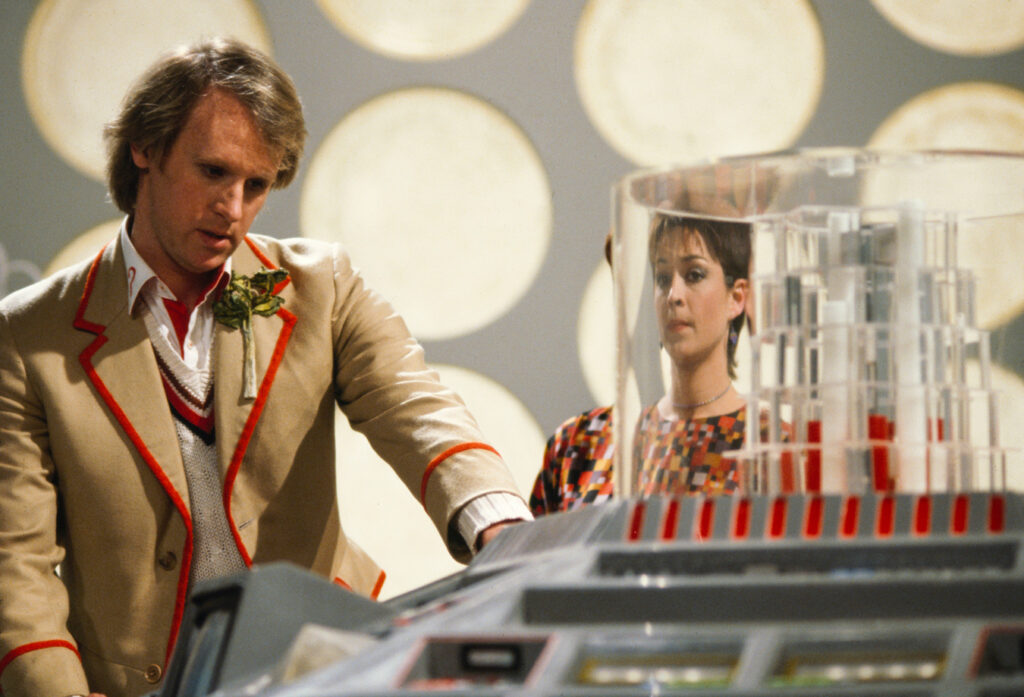
‘The Five Doctors’, 1983
The 20th anniversary was celebrated in style with this 90-minute epic get-together of all the Doctors so far. Sort of. William Hartnell had sadly died by this point, and so the part of the First Doctor was recast, with Richard Hurndall taking over the role. And the recently departed Tom Baker declined to take part – so clips from the unfinished ‘Shada’ story were used to represent the Fourth Doctor. Madame Tussauds were kind enough to lend their waxwork of Tom for some fan-pleasing publicity photos, however.
‘The Caves of Androzani’, 1984
Regularly topping fan polls as the greatest Doctor Who story of all time, this gritty tale of corrupt politicians and grimy gun-runners was a spectacular finale for Peter Davison’s Fifth Doctor. Poisoned by some alien flora, he gives up the last of the precious antidote to save his companion Peri (Nicola Bryant). Thus his life flashes before his eyes — and he turns into Colin Baker. “You were expecting someone else?” the Sixth Doctor asks a bemused Peri.
‘Vengeance on Varos’, 1985
A corrupt and rotten government tortures and films its political prisoners and broadcasts the video nasties as a form of entertainment for the goggle-eyed masses. Pre-dating the concept of reality television, this at-times-disturbing serial was ahead of the curve. Complaints about the levels of violence from the likes of BBC1 Controller Michael Grade seemed to rather miss the point — that the story itself was a critique of the bloodthirsty state of TV.
‘The Trial of a Time Lord’, 1986
After an 18-month hiatus imposed by Mr Grade, the show returned with a truncated series that makes a deliberate effort to tone down the violence. The 23rd season consists of a single 14-episode serial — albeit one broken up into four distinct stories. The Time Lords have once again put the Doctor on trial, mirroring the real-life situation — which the fans perceive as the future of Doctor Who itself hanging in the balance. There were campaigns. And a charity single.
‘Time and the Rani’, 1987
While the show was renewed for another season, Sixth Doctor Colin Baker was unceremoniously sacked from the lead role. Colin quite understandably refused to come back to shoot a regeneration scene. Therefore, the transformation from the Sixth Doctor into the Seventh – apparently triggered by falling off an exercise bike – is achieved by new incumbent Sylvester McCoy donning a curly blond wig while his face is obscured by a special effects blur.
‘The Happiness Patrol’, 1988
On a planet where it’s illegal to be unhappy, despotic leader Helen A’s chief executioner is a robot constructed from confectionery, known as the Kandyman. Bassett’s – the company that makes Liquorice Allsorts – felt that the psychotic sweetie was rather too close in design to their Bertie Bassett mascot and made a complaint. An internal BBC investigation concluded that the similarities were coincidental – but producers did have to promise never to use the character again.
‘Survival’, 1989
The ironically named ‘Survival’ was the last episode of the original 26-year run of Doctor Who to be transmitted. The makers of the show suspected that this might be the case, and so a hastily scripted final scene was added, depicting the Seventh Doctor and his companion Ace (Sophie Aldred) walking off into the distance, while a voiceover from Sylvester McCoy lets us know that their adventures would continue: “Somewhere there’s danger, somewhere there’s injustice, and somewhere else the tea’s getting cold. Come on, Ace, we’ve got work to do!”
‘Search Out Space’, 1990
Although no new series appeared in 1990, viewers did get to see what the Doctor and Ace got up to next. A special episode of a BBC educational programme had the characters competing in ‘The Ultimate Challenge’, the biggest gameshow in the universe. This was mainly an excuse to explain various aspects of astronomy and geometry, but by this point fans were happy to devour whatever scraps they could get.
Timewyrm: Genesys, 1991
Virgin Publishing comes to the rescue of devotees experiencing Doctor Who cold turkey with a series of fully licensed original novels starring the Seventh Doctor and Ace and promoted as the official continuation of their TV escapades. The first of these ‘New Adventures’, however, causes a bit of a tabloid stir by prominently featuring underage temple prostitutes and excessive nudity. To be fair, the blurb on the back did flag the books as being “too broad and too deep for the small screen”…
Transit, 1992
The New Adventures novels reach new heights with this 1992 volume which includes what has become fondly known as ‘the semen scene’ – in which a prostitute eats some nuts to take the taste of ejaculate out of her mouth. (There were a lot of prostitutes in these books for some reason.) While it probably was an artistically valid choice on this occasion, most branches of WHSmith were still naively stocking the novels in their children’s sections.
‘Dimensions in Time’, 1993
For a short while it seemed as if the 30th anniversary would be celebrated with a special feature-length drama called The Dark Dimension. But then that was cancelled, and we ended up with a pair of mini episodes that crossed over Doctor Who with EastEnders and were broadcast as part of Children in Need. They’re magnificent in their own way, however, and all the living Doctors took part. Where else can you see Pat Butcher sharing screen-time with a Cyberman?
Disney Club, 1994
With no new series materialising on the BBC, the Doctor went to try his luck over on one of the commercial channels. Sylvester McCoy made an appearance in full character and costume as the Seventh Doctor on ITV’s Disney Club. Ostensibly there to help one of the presenters build a time-travelling shower, is his true purpose to put the pieces in place for a modern merger with the mouse corporation…?
Downtime, 1995
With Doctor Who having been off the air for six years, fans were becoming so desperate for new material that some of them began making it themselves. A few dozen semi-professional fan-films were produced over this period, and Downtime — by Reeltime Pictures — is one of the slickest of the lot. Producer Keith Barnfather persuaded several stars to return to their TV roles, including Elisabeth Sladen as Sarah Jane Smith and Nicholas Courtney as the Brigadier.
Doctor Who: The Movie, 1996
The second coming! Seemingly from nowhere, it was announced that Doctor Who would be returning to BBC1 in a US TV co-production, with Paul McGann as the Eighth Doctor. Sadly, this turned out to be a one-night stand, with just one 90-minute special being produced, but for one glorious night the show was back. Fans were outraged by the Doctor being revealed to be half-human, and — even more shockingly — by him kissing a woman.
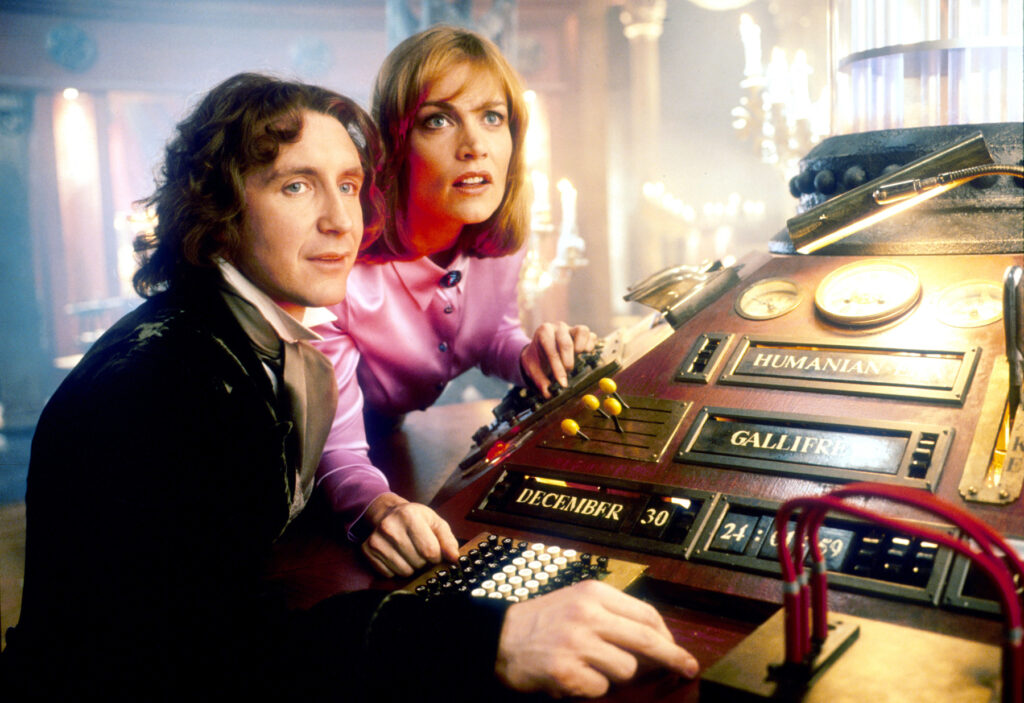
Destiny of the Doctors, 1997
A small amount of new footage materialised which had been specially shot as part of a new CD-ROM video game adventure. Destiny of the Doctors ignores the newly minted Eighth Doctor – presumably for licensing reasons – and focuses only on the first seven. The real star, however, is Anthony Ainley, who reprised his role as the Master in live-action clips that appear between levels. Some fans claim that it was his finest performance.
The Scarlet Empress, 1998
For various reasons, the Paul McGann-led production had not been made into a series, and in the minds of many, the TV show was now dead. In the literary world, however, the Doctor Who brand was thriving, with the BBC having taken the licence back in-house. They published two novels per month: one featuring the ongoing adventures of the Eighth Doctor, and one focusing on a past Doctor. The Scarlet Empress by Paul Magrs is an excellent example of the former. Full of outlandish imagery and magical realism, it reinvented Doctor Who for a bit.
‘Curse of the Fatal Death’, 1999
When future show-runner Steven Moffat was tasked with writing a comedy drama for Comic Relief night, he chose to produce a Doctor Who script. This saw the ‘Ninth’ Doctor — played by Rowan Atkinson — burning through his remaining regenerations. The various incarnations were played by Richard E. Grant, Jim Broadbent and Hugh Grant, before finally a female version (gasp) was portrayed by Joanna Lumley.
The Fearmonger, 2000
Independent production company Big Finish had secured the rights to produce Doctor Who audio dramas the previous year and were by now releasing them regularly on CD – with previous Doctors Peter Davison, Colin Baker and Sylvester McCoy, plus a cavalcade of companions, all agreeing to reprise their TV roles. The Fearmonger was an early high point that featured the Seventh Doctor and Ace coming up against a fascist regime in the UK of the near future…
Storm Warning, 2001
There were jubilations when Paul McGann agreed to record audio adventures for Big Finish Productions as the Eighth Doctor. Starting with ‘Storm Warning’, a derring-do tale of airship disaster, we suddenly had ongoing episodes performed by the incumbent Doctor again. This was as good as things were ever going to get now, surely?
Death Comes to Time, 2002
In 2002, Doctor Who invented streaming television with this animated ‘webcast’ starring Sylvester McCoy and Sophie Aldred as the Seventh Doctor and Ace. In reality – for most of us, in those early internet days – it meant waiting half an hour for each three seconds of juddering footage to download. But it was still ground-breaking. And took the unusual step of apparently killing off the Doctor completely. (We now ignore this.)
Scream of the Shalka, 2003
For the 40th anniversary in 2003, the BBC online team decided to relaunch Doctor Who as a series of animated webcasts starring Richard E. Grant as the Ninth Doctor, with ‘Scream of the Shalka’ the first thrilling instalment. Unfortunately, it seems that no one told the people developing this idea that behind the scenes, other plans were being made… And on 26th September fans got the best present ever, as it was announced that Doctor Who would return to BBC1 with a new live-action series in 2005. ‘Scream of the Shalka’ was largely ignored and further webcasts were canned.
Medicinal Purposes, 2004
In this, the last of the ‘wilderness years’ before the grand television comeback, the books, comics and audios of original adventures continued to be produced in vast quantities — their publishers were perhaps nervous that their days in the spotlight were numbered. The audio drama Medicinal Purposes, which dealt with infamous body-snatchers Burke and Hair, is now notable for one of its cast members. Appearing as relatively small guest character ‘Daft Jamie’, there was a young actor and hardcore Doctor Who fan by the name of David Tennant…
‘The Parting of the Ways’, 2005
Doctor Who made a triumphant return and became an instant hit with a whole new generation overnight. Christopher Eccleston was the Ninth Doctor and pop star Billie Piper proved her acting chops as companion Rose. Eccleston would only feature in this single series — due to some backstage bother that was never fully disclosed — and in the final episode he kisses Rose to absorb the time vortex from her… and then regenerates into David Tennant.
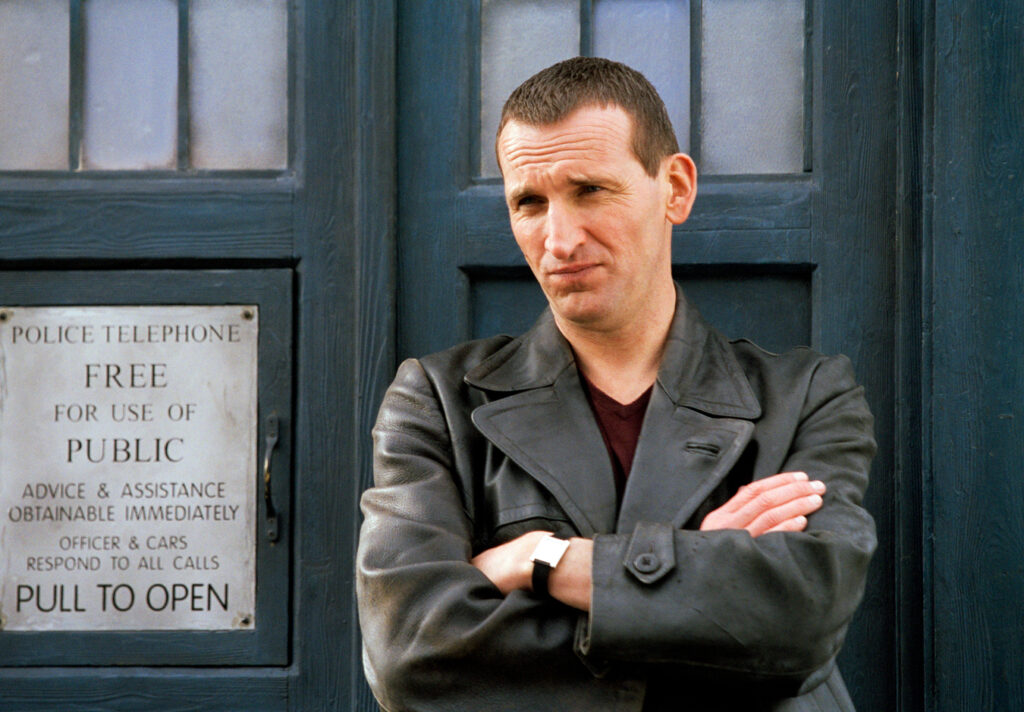
‘Doomsday’, 2006
Amazingly, the Daleks and the Cybermen had never met each other on screen, but they finally do in this episode scripted by Russell T Davies. The two big baddies come faceplate to eyestalk during the Battle of Canary Wharf, at the top of the iconic tower. “Daleks, be warned. You have declared war upon the Cybermen,” growls the Cyberleader. “This is not war,” declares a bitchy Black Dalek, “This is pest control.”
‘Voyage of the Damned’, 2007
Doctor Who has often been accused of veering towards camp, and is sometimes is guilty as charged. But perhaps never more so than when a guest-starring Kylie Minogue sacrifices herself to save a space-faring version of the Titanic on Christmas Day. The tradition of a special episode being broadcast at Christmas very quickly became a permanent fixture that was as keenly anticipated as the Queen’s Speech. (The late Queen Elizabeth II is in this as well, by the way, voiced by Spitting Image veteran Jessica Martin.)
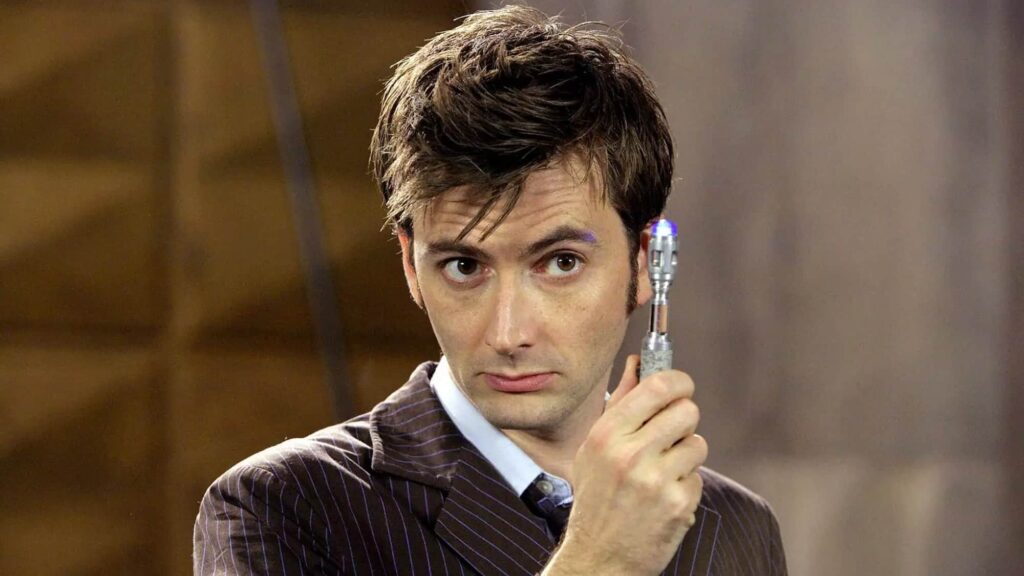
‘The Doctor’s Daughter’, 2008
In this adventure the Doctor forcibly has a tissue sample taken from him and used to grow a ‘daughter’. Notably, the actress playing this character – Georgia Moffett – really was the Doctor’s daughter – as her father is Peter Davison, the Fifth Doctor. And after making this episode, Tenth Doctor actor David Tennant would go on to marry her. Once asked at a convention what the strangest thing that a fan had given him was, Davison memorably replied: “Grandchildren.”
‘The Wedding of Sarah Jane Smith’, 2009
2009 was something of a ‘gap year’ for the main series, with only three special episodes being broadcast. But the Doctor could be found elsewhere – if you knew where to look. CBBC spin-off show The Sarah Jane Adventures, starring Elizabeth Sladen, was in its third series by now, and this instalment deals with Sarah Jane getting hitched. The surprise ending of the first episode sees the Doctor crashing her wedding and insisting that the ceremony be halted immediately…!
‘Vincent and the Doctor’, 2010
After regenerating into Matt Smith on New Year’s Day, one of the Eleventh Doctor’s most memorable adventures this year was a trip back to 1890 to meet Vincent van Gogh. Written by romcom supremo Richard Curtis, the adventure deals with themes of depression and mental health as the Doctor and Amy Pond (Karen Gillan) help the troubled artist to defeat an invisible monster.
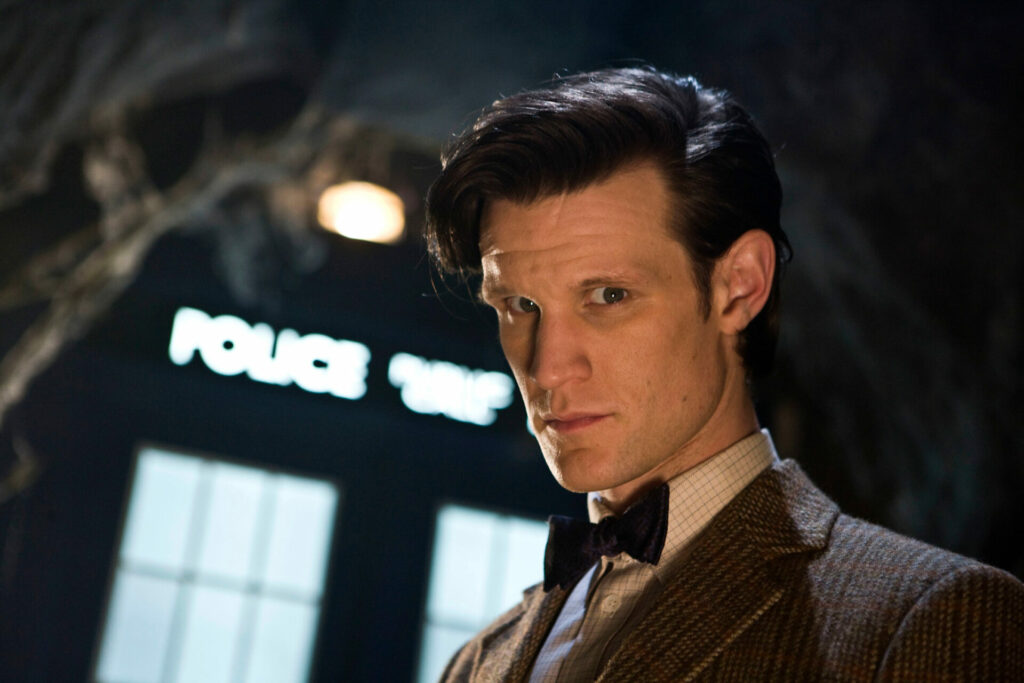
‘The Doctor’s Wife’, 2011
A delicate and beautiful script from fantasy giant Neil Gaiman had the Doctor’s only constant companion — the TARDIS — transformed into human form, meaning that he could finally converse with what the title playfully refers to as his ‘wife’. A spellbinding performance from Suranne Jones as the personification of the space-time machine really has us believing that she is infinitely complex and most definitely ‘bigger on the inside’.
‘The Angels Take Manhattan’, 2012
Living statues the Weeping Angels are probably the biggest monster hit of the revived era of the show, and this episode sees the ultimate expression of that as the Statue of Liberty is transformed into a giant ravenous monster. The story ends with the ‘lonely assassins’ sending companion Amy Pond and her husband Rory (Arthur Darvill) back into the past where — for complicated script reasons — the Doctor can never visit them again.
‘The Day of the Doctor’, 2013
The 50th anniversary was a big deal, and the centrepiece of the celebrations was a special feature-length episode filmed in 3D. ‘The Day of the Doctor’ was screened in cinemas as well as being broadcast on BBC1 and saw three Doctors teaming up to put an end to the Time War between the Daleks and the Time Lords. While David Tennant was more than happy to return, Christopher Eccleston unsurprisingly declined, and so a new ‘hidden’ incarnation was created — the War Doctor, played by John Hurt.
‘Dark Water / Death in Heaven’, 2014
Peter Capaldi’s first season as the Twelfth Doctor concludes with a two-part story that received complaints for being too scary, after suggesting that the dead feel the pain of cremation. The first part ends with a jaw-dropping reveal – that the mysterious woman who’s been popping up all series is, in fact, a female incarnation of the Master – now calling herself Missy and played by Michelle Gomez.
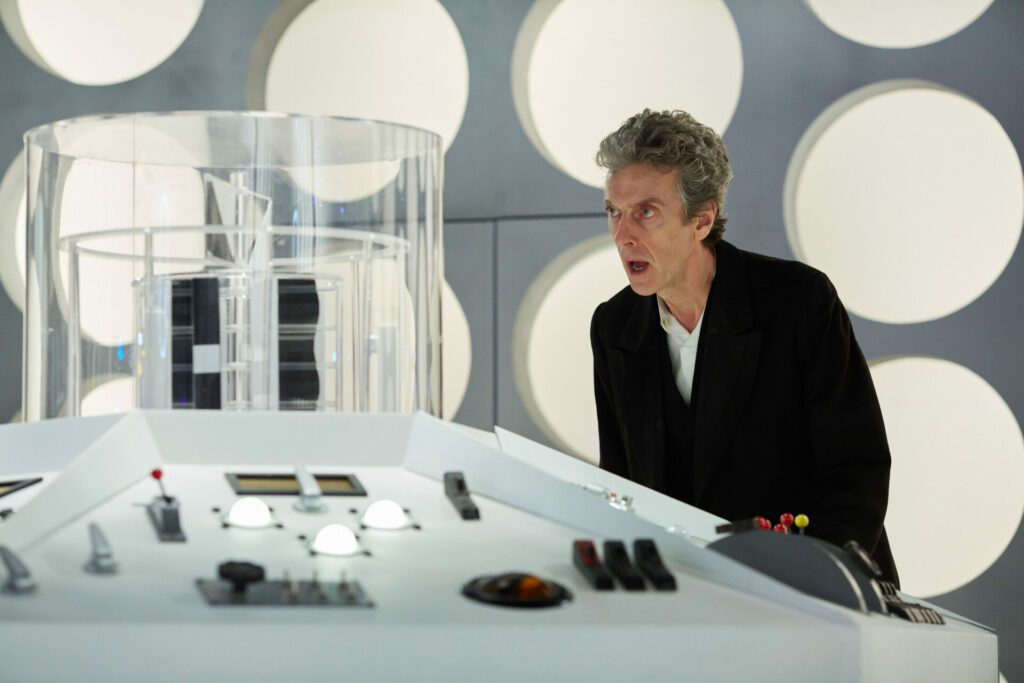
‘Heaven Sent’, 2015
While he was showrunner, writer Steven Moffat liked to set himself challenges, and this episode is one of his absolute masterpieces. It’s a one-man show, with Peter Capaldi performing the entire piece alone. There’s a shuffling, hooded creature that pursues him, and some fleeting memories of companion Clara (Jenna Coleman), but otherwise he carries the entire story singlehandedly. Magnificent.
‘The Return of Doctor Mysterio’, 2016
Doctor Mysterio is what Doctor Who is called in Mexico, and while visiting the country on a promotional tour, Steven Moffat fell in love with the name and decided to use it in an episode title. This Christmas special capitalises on the trend for superhero movies and features a young boy gaining special powers after swallowing an alien gem given to him by the Doctor – mistakenly thinking it to be medicine.
‘Twice Upon a Time’, 2017
For the Twelfth Doctor’s final story, it was decided to have him team up with his first incarnation. With neither actor who had previously portrayed the First Doctor still around, an ingenious casting solution was hit upon, and the part went to David Bradley, who had played William Hartnell in An Adventure in Space and Time, a 2013 docudrama about the origins of Doctor Who. Bradley has continued to perform as the character on both screen and audio ever since.
‘Rosa’, 2018
Jodie Whittaker smashes through the TARDIS glass ceiling and becomes the first full-time female incarnation of the Doctor — much to the fury of some of the fandom. One of her earliest adventures involves travelling back to Alabama in 1955 and meeting civil rights hero Rosa Parks in a sensitive script co-written by new showrunner Chris Chibnall and popular children’s author Malorie Blackman.
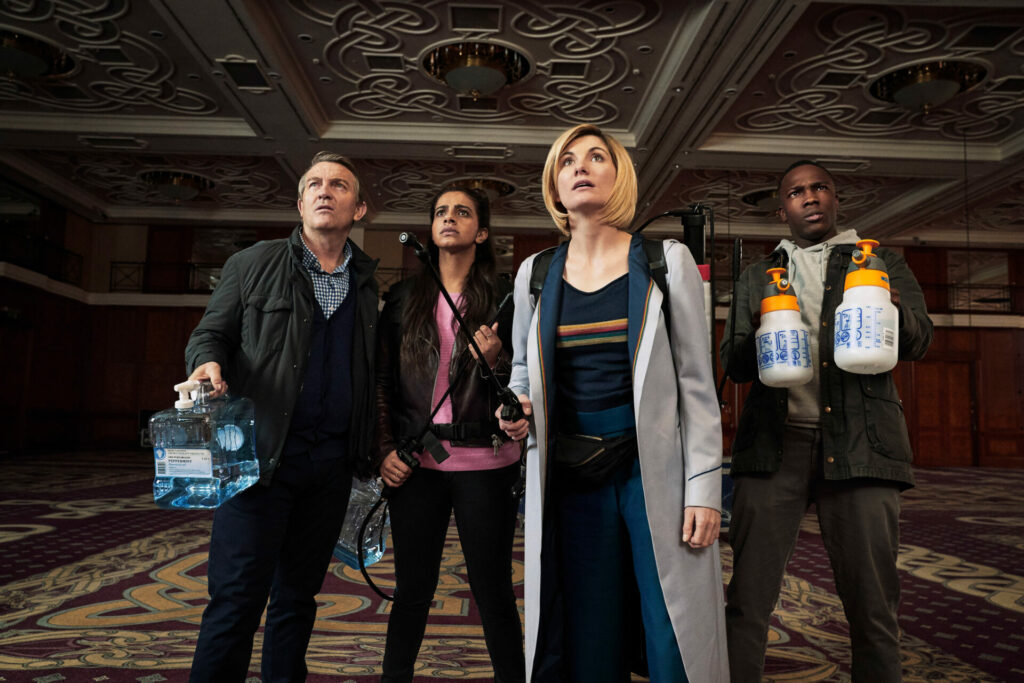
‘Resolution’, 2019
In a controversial move, Chris Chibnall opted to move the seasonal special episodes away from their traditional Christmas Day slot and instead air them on New Year’s Day. The first of these relocated revelries is ‘Resolution’, which sees the Thirteenth Doctor finally come up against the Daleks. Well, one Dalek, which memorably spends a lot of the story out of its metal casing and in full mutant squid monster glory.
‘The Timeless Children’, 2020
This season finale takes the dramatic step of revealing that the First Doctor hadn’t been the first Doctor after all, and that there were in fact goodness knows how many of them. It turns out that the Doctor wasn’t even from the planet of the Time Lords and had been found as a child, abandoned by a portal to another dimension. The mystery of Doctor Who’s title is restored!
‘Flux’, 2021
Due to the limitations of filming during a pandemic, this series was scaled down to only six episodes, all of which made up one big storyline. But making the most of the hand that they’d been dealt, cast and crew pulled together to make an enormous and gripping adventure that threatens the destruction of the entire universe. One of the best seasons of the modern series.
‘The Power of the Doctor’, 2022
Not only was this the grand finale for Jodie Whittaker’s magnificent Thirteenth Doctor, but it also served as a celebratory party for the 100th anniversary of the BBC itself. Author Chris Chibnall threw everything into the mix — Daleks, Cybermen, the Master, old Doctors and old companions. It was a spectacular end to the era and ended with Jodie regenerating into… David Tennant. Just in time for this year’s 60th-anniversary specials.
